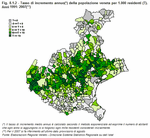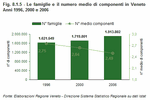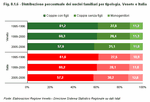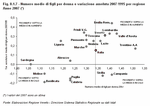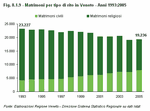|
8 - Family income and consumption
Population trends are in constant evolution. In the late seventies important changes were beginning to take place such as increased life expectancy, thanks to better health conditions and economic well-being. The decrease in the number of births, due to social and economic changes in society led women to have children later in life, thus leading to a reduction in the number of children, and consequently an increasingly marked proportion of elderly people compared to younger age groups.
These changes are inevitably reflected in family structures: it goes without saying that structural changes for family members have an effect on family profiles. The profound changes in the family as an institution that have been seen at the beginning of this third millennium have their roots in the second half of the last century: the increase in the number of separations and divorces, the decrease in births, women's access to the labour market and the increase in migration flows. The family continues to play a key role in Italian society and is irreplaceable for individuals and for society: it is a privileged place where affection and a caring environment can be found, where children are brought up and educated, where important economic decisions are taken and where individuals in difficulty find support and protection. Acknowledging these changes and allowing families to find a balance and a new role in contemporary society is essential for harmonious social development. Many factors affect families' quality of life, from the population changes that are characterising our society and their repercussions on family structures and networks, to questions of lifestyle, quality of living, disposable income and consumer choice, reconciliation of work and family life. 8.1 - Demographic trends
According to the latest data available recorded in August 2007 (provisional data), the resident population of Veneto is 4,809,076 inhabitants. This figure has grown constantly for over a decade and has increased by 1.5% since 2006. (Figure 8.1.1)
The largest concentrations are in the provinces of Padova, Verona and Treviso, each accounting for over 18% of the whole population; Vicenza and Venezia account for 17.6% and 17.5% of the population, while Belluno and Rovigo have much lower shares, around 5%. Compared to 2005, Verona has had the highest increase, +2.3 percentage points, followed by Treviso (+1.9%) and Padova (+1.6%). Population change for Belluno and Rovigo however measures less than half a percentage point. Since 1991, the population in Veneto has grown at a rate of about 6 persons per 1,000 registered inhabitants. Population growth has affected nearly 78% of municipalities in the region, in which 79% of the population lives and whose growth rate is on average 9.1 persons per thousand residents. This increase has affected mainly the central area of the region, while municipalities whose populations have declined are mainly in mountainous areas or in the areas of the 'pianura padana' as well as the provincial capitals of Venezia, Padova, Rovigo and Treviso. (Figure 8.1.2) Veneto has greater population growth than the rest of the country, and with a more marked increase than the previous year. While natural growth is very low both in Veneto and in Italy, it is the increasing migration in Veneto which makes the difference. (Table 8.1.1) It is largely the appeal of our region that is responsible for the increase in total inhabitants. Positive net migration, which is particularly high for provinces in the centre of the region, reveals that population growth is due to the entry of new residents, mainly from outside of Veneto. Movement between provinces in Veneto is more limited: the provinces of Padova and Verona have the highest internal migration flows in the region. Natural growth, however, is more limited in all the provinces due to increased longevity and decreasing fertility which is halting the number of births. In some provinces the natural balance is negative: In 2006, Belluno, Rovigo and Venezia registered a higher number of deaths than births while Treviso and Vicenza made the greatest contribution to natural population growth registering higher balances, due mainly to the number of births to foreign women: indeed Treviso and Vicenza have the highest share of foreign residents, accounting for 9.1% and 9.0% of the Veneto population in 2006. (Table 8.1.2) The low birth rate which has persisted for over 20 years, combined with increased life expectancy has made Italy one of the oldest countries in the world. Veneto is in line with national demographic trends: although the population is ageing slightly more slowly than the national population, 2006 saw a proportion of nearly 139 elderly people, aged over 65, for every 100 young people in the 0-14 age group, with a 2.7 percentage point increase since 2001. This phenomenon seems to be growing, registering a steadily increasing imbalance in the composition of the whole population. In the last twenty years the elderly population has grown considerably, for while in the 1981 census it accounted for 13% of the population, today it accounts for over 19%. In particular there has been a considerable increase in the number of over-80 year-olds. Furthermore, this growth seems set to continue: according to population projections, the elderly population will increase and by 2025 may account for up to 26% of the population. (Figure 8.1.3) and (Figure 8.1.4) There is an increasing imbalance between the young and the old, between those who produce or have the potential to do so, and those who draw benefits from past activity. A re-dimensioning of the active population could bring about important changes in the labour market. As for changes in the family, it is impossible not to foresee an increasing demand for care for elderly people. This will weigh on an increasingly reduced number of family members who are, on average, older than before.
In the last ten years there has been a considerable increase in the number of families (Note 1), nearly 300,000 more than in 1996, but family size has decreased, with the number of components dropping to 2.49 in 2006. The number of families is increasing at a considerably faster rate than the population: According to census data, Veneto's population grew by 3.4% from 1991 to 2001, while the number of families increased by 14.2%. This latter increase thus cannot be attributed to population increase alone: there is a greater number of families in Veneto but they are getting smaller and smaller due to the considerable decline in fertility, increased marital instability and the ageing population. Furthermore, less traditional family structures are on the rise: the number of one-parent families, reconstituted families, single persons and aggregated nuclei (Note 2) is growing. (Figure 8.1.5)
In line with national trends, Veneto has had an almost 4 percentage point drop in the number of couples with children as share of total of family nuclei but an increase in the number of couples without children. Most of these are elderly people; but for the others, the increasing trend is partly due to the fact that most women, and hence couples, have been deciding to delay the birth of their first child. In 2004 the average age of mothers giving birth was slightly above 31 years, versus the 30 years and 7 months in 1993, figures which are slightly above the national average. (Figure 8.1.6)
In the last ten years, both Veneto and other regions have seen a slight pick-up in fertility. The number of children per woman in Veneto is estimated to be 1.38 for 2007. The figure has remained the same for the last three years and has recovered since 1995 when it hit the regional low of 1.08 as well as a national low. It is still far from the replacement rate of 2.1 children per woman. (Figure 8.1.7)
If we compare Italian regions, Veneto has witnessed a more marked increase in fertility than the Italian average, with a 0.31 increase in 2007 from 1995. This trend seems to be in line with that of many regions in the north, and some central ones, namely Trentino Alto Adige, Lombardia, Emilia Romagna, Lazio and Valle d'Aosta. The remaining central and northern regions lie below the national average, though with an increase compared to 1995. The situation is different for southern regions: there has been a slower increase in fertility, though Sicilia and Campania are above the national average. The recent pick-up in fertility to which mainly northern regions have contributed, is partly due to the increasing presence of foreign residents, who are more inclined to have children (in 2004, 18.9% of births were to at least one foreign parent); in 2005, the average number of children per Italian woman was 1.32. If we calculate this indicator for the Italian and foreign components of the resident population we get 1.24 and 2.41 children per woman, respectively. The immigrant population in Italy comes from countries with different reproductive patterns to those in Veneto. These patterns are maintained for a few years, but they are destined to adapt to Italian reproductive and demographic patterns. This pick-up, however, may also be attributed to Veneto women's postponing having children until they have found a balance in terms of relationship, work and living conditions. The curve for specific fertility rates of Veneto women by age in 2005 highlight the fact that compared to ten years earlier, women are choosing to have children later in life. This is evidence of a profound change in reproductive behaviour: women in Veneto have fewer children than thirty years ago - the average number of children per woman in 1970 was 2.39 - and they have them at a later point in life. It is not easy to understand exactly why women now decide to have fewer children than in the past. Delaying having children certainly has an effect on the number as it becomes physically impossible to have children beyond a certain age and it is known that after 35 years the risks increase. From a biological point of view one could advance the hypothesis that there is a weakening of the survival instinct and the sense of biological continuity, but the changes in cultural models cannot be ignored. On the one hand there is an increasing tendency for parents to focus their energy and attention on a limited number of children so that they are lacking nothing. This would explain, at least in part, parents' tendency to keep their children in the family home for longer. On the other hand there are those who claim that the main purpose of families today is not to have children, and that procreation is not an essential characteristic of a family: the family as institution has been redefined in recent cultural debate and, unlike a few decades ago, today families are not judged by the number of children they have. While having a lot of children was a way for parents to transfer their hopes for success, today this ambition is directed more and more towards the couple (or the single) since today they are capable of achieving what previously could only be achieved through one's children. Looking at the average number of children desired, according to the most recent data for 2003, both men and women in Veneto would like at least two (2.1 to be precise, exactly the same figure as for Italy). This desire, which is not met, derives in part from the cultural model of the traditional nuclear family with two children (preferably a boy and a girl) and in part from a true desire which cannot be met. (Figure 8.1.8)
While on the one hand there is a progressive reduction in the number of births, on the other there is an increase in the number of adoptions by parents in Veneto and Italy. The number of requests for adoption of Italian minors was 824 in Veneto in 2005, while for foreign minors there were 513 requests. Both figures were slightly lower than for the previous year.
From the moment of requesting adoption the process is quite long, particularly in the case of Italian minors. Once a request for adoption has been presented, the Juvenile Court will appoint a local social services agency to carry out a study of the aspiring adoptive parents. Once the Court has decreed that the couple is suitable, procedures start to find a child for the couple. The total number of national adoptions has grown since 2003. In 2005, 124 Italian minors were adopted in Veneto, 63% of whom were children declared to have been abandoned, while the remaining 37% came under the remaining categories, such as orphans who were already being brought up by other relatives. As regards foreign children, the number of children rose from 274 in 2003 to 292 in 2005. Adopting foreign minors is faster and less complex and it is often easier to adopt a very young child if they are of foreign origin. This is why couples who present requests to adopt both Italian and foreign minors are increasingly opting for the adoption of a foreign child. On average the husband is aged about 50 and the wife 38 and in over 50% of cases the couple have been married for at least six years, in both Italian and foreign adoptions. According to data from the Commission for international adoption, in 2006 300 couples in Veneto asked for authorization of foreign children to enter Italy for adoption or fostering.
Closely linked to the decline in fertility is the decrease in marriages (Note 3). In 2005 the number of marriages celebrated in Veneto dropped: since 1993 there has been a drop of almost 18%. Not only are there fewer marriages, but couples also marry later: The average age for first marriage in Veneto has gone up from 29.2 years in 1993 to 33 in 2005 for grooms, while for brides it has gone from 26.5 to 30.2. (Figure 8.1.9)
Having children out of wedlock, or as a first step towards marriage is becoming more common: Cohabitation has become common practice in the western world in the last ten years, so much so that it is no longer stigmatized by society as it may have been a few decades ago. Before 1974, in Italy only 1.4% of marriages were preceded by a period of cohabitation. This rose to an average of 25.1% for the years 1999-2003, and 34.1% in North-East Italy. It is important to emphasise that the increase in pre-marital unions is also linked to the increase in marital instability. According to Italian data for 2003, the number of cohabitating couples in which one partner is waiting for a divorce to come through has increased from 5.4% to 17.5%. In Veneto, as in Italy, most children however are born to a married couple. Despite the increase in the number of non-married couples living together, married women are more inclined to have children since it's considered preferable for a couple to be more stable and with future prospects when having children. In 2004, 14.3% of children were born out of wedlock in Veneto. While this figure, which is slightly higher than the national figure (13.7%), is relatively contained, it is double the figure for 1995. Even when couples choose to marry, there has been a constant increase in the number of civil rites. In Veneto the percentage was 41.2% in 2005, which is above the national average of 32.8%. This change in habits can also be traced to the growing phenomenon of marital instability, as divorcees are obliged to have a civil rite for their second (or subsequent) marriage. (Table 8.1.3) The number of re-married couples in Veneto 2005-2006 was 71,000, 54.3 of which had children. An emerging phenomenon as regards family trends is the celebration of marriages in which at least one spouse is foreign. This reflects the increasing presence and integration of foreign residents in the region. In 1998, this regarded 7.1% of marriages in Veneto, while in 2005 this percent rose to 19.3% (as opposed to 13.3% national average). (Figure 8.1.10)
The last ten years have seen a considerable increase in the number of separations and divorces. In 2005, 6,157 separations and 4,052 divorces were granted. The proportion of separations on married couples almost doubled from 1993 to 2005. Separation is the first administrative step in the dissolution of a married couple. For many couples this is also the final step since many separations do not then progress to divorce (in Italy in 1995 nearly 4 out of 10 did not conclude with divorce in the following decade). However, a recomposition of the marital union happens only in few cases. (Figure 8.1.11) and (Table 8.1.4)
The average duration of marriage at time of separation is around 13 years, but this figure is declining: Hence, not only the number of union dissolutions is increasing, but marriages are also lasting less and less. There is a decrease in separations before the fifth year of marriage, and a slight increase in couples that have been married for at least 20 years. These couples account for 22.8% of total separations in Veneto, and 24.6% in Italy. There has been an increase in the number of separations involving children born in the marriage (64.9%). Separations with minors increased by 3.6 percentage points from 2000 to 2005, reaching 47.7%. There are 5.4 minors involved in separation per thousand minors resident in Veneto, which is slightly lower than the national average of 6.4 per thousand, but above the 4.3 recorded in 2000. These children are generally left in custody of their mothers (74.8% of cases following separation and 77.3% following divorce in 2005). The chance that the father obtains sole custody increases as the children get older. However it is important to highlight the growing trend of joint, or alternate custody which has marked the last few years. In total over 17,000 children were involved in new separations from 2000 to 2005.
Declining fertility rates, which in Italy started in 1965 and reached a historical low in 1995 of 1.19 children per woman, have had a significant impact on average family size and composition. It is therefore interesting to look at how these new births, albeit reduced in number, are distributed within families. (Figure 8.1.12)
On the one hand the number of couples with children has decreased, but on the other, couples that decide to have children generally tend to have at least two. On a national level the number of couples with only one child seems to be increasing, which is matched by a decline above all in the number of couples with three or more children. In Veneto, however, the tendency is the opposite: From 1998 to 2006 the number of couples with at least two children seems to have increased by almost 5 percentage points. 44% of Veneto couples have two children, while 8.2% have at least three. So though it is true that children arrive later and the number of childless couples is increasing, it is also true that Veneto couples who want children and are able to, tend to have more than one. There is thus a specific childbearing trend in Veneto, whereby two quite distinct types of nucleus can be defined: those who don't have children, and those who have at least two. The increase in both these categories is matched by a decline in couples with just one child.
The increase in the number of families is also related in part to the progressive slimming down of the family, with a reduction in the number of members and a disintegration of extended families. The number of families with at least five members, which today are considered large families, has clearly declined since 2005, though Veneto has seen a quite sharp fall of 2.4 percentage points. The same trend can be seen for extended families or with added members, though in Veneto the figure for this type of family is higher than the national figure: This is evidence of the persistence of the extended family model in Veneto, which consists not only of the traditional family but also of other components, usually the elderly or other relatives. (Figure 8.1.13) and (Figure 8.1.14)
The number of one-parent families has remained more or less constant and, according to the latest available data they make up 11% of family nuclei, mainly consisting of single mothers with minors (83%). These women are mainly widows (according to national data in 2004, 52.8 of 100 women alone are widows), 39.5% are separated or divorced and a small share are single mothers (7.7%). Women outnumber men in terms of single parenthood because average life expectancy is higher for women and also because mothers are more often granted custody in divorce cases: according to the latest data for 2004, mothers won custody of minors in 77.9% of separations, and in 80% of divorces. Thus it often happens that, following separation or divorce where children are involved, from one family emerge two or more: the mother with the children makes up a one-parent nucleus, while the father becomes a one-person household.
The number of one-person households has grown in recent years. In Veneto this regards the elderly population above all: as a consequence of population ageing and increased life expectancy there is an increase in the number of single elderly people. In Veneto alone they accounted for 13.6% of families in 2005-2006. 69.6% of single women are at least 60. But the share of single people aged less than 60 is also increasing: while it is true that young people are finding it harder to leave the family home, there has also been an increase in the number of single people following the increase in marital instability. (Figure 8.1.15) and (Table 8.1.5)
The postponement of marriage means that young people stay in the family home for longer. In Veneto 53.6% of single young people in the 20-24 age group, more men than women, live at home and thus delay gaining independence and starting their own family. Even if we consider the older ones, aged 30-34, almost one in three (31.5%) still live with their parents, and this figure has grown since the 2001 census (27%). The difficulty these people have in leaving home from when they come of age up to the age of 34 cannot simply be explained by the lengthening of school education, the difficulty in finding a stable job or the desire for economic stability. When young people in Veneto are asked why they live with their parents for so long, 21.6% say they are still studying, 39.9% say they have financial difficulties and could not afford to live alone. Most often however, living at home with their parents is a choice: over half (53.6%) of young people in Veneto say they are happy living with their families and say that they can nevertheless enjoy their freedom. This is partly due to the change which has taken place in parent-child relationships. Now they are less hierarchic and young people can be independent while living at home. This delay in leaving the nest and possibly starting a family, is in line with the drop in childbearing desires and the consequent low fertility.
Certain aspects of daily living are certainly important in an evaluation of the quality of family life, which is undoubtedly influenced by possession of goods and an advantageous financial situation - which will be dealt with in the following chapter. Relationships, quality of living conditions and residential context provide added value, which is reflected in the life satisfaction perceived by families.
Home is a primary good for families, and the desire to own one's own home and willingness to invest, and risk a great deal to own a home is typical of families in Italy and Mediterranean Europe. Home is where most family activities take place, so much so that we could say that there is no family - meaning relationships - if there is no home. Strong family relations are established where there is also a physical place to cultivate them. There are more home-owning families in Veneto (72.2%) than in Italy, 17.6% of whom have a mortgage to pay. Among factors which strongly influence a family's perception of their quality of life is also how they view their home, not surprisingly if we consider its perceived importance. Homes are seen as smaller and smaller, but in better condition than ten years ago. The data on irregularity in the provision of water, which regards 8.2% of families in 2006, is interesting, though better than the Italian average (14%). (Figure 8.1.16) Residential environment also has an important effect on families' perceptions of the quality of life. The most persistent problems are related to traffic. Traffic, both in Veneto (50.4%) and Italy (46.1%) comes top, despite its having decreased considerably from 1996 to 2006. Problems related to the environment such as air pollution and noise, though decreasing, are still the most critical issues for families, particularly in municipalities with larger populations and more urban centres. According to most recent data, pollution is more strongly felt in Veneto (44.3%) than in Italy (40.9%), while problems related to noise are at 32.3% in Veneto but above 35 percentage points in Italy. This tendency in spite of the recent alarms related to the environment and pollution can be partly attributed to families' tendency to move from provincial capitals to municipalities in the outskirts, which have seen a 41.2% rise in the number of resident families from 1981 to 2001, as opposed to 8.2% in the provincial capitals. Recent years have also seen people getting used to living with traffic, pollution and noise so perhaps they perceive them as less of a problem. Satisfaction with public transport seems to have improved in the last decade, while the perception of one's residential environment as being at risk of crime has increased. (Figure 8.1.17) In order to understand the type of family relationships and satisfaction with them it is important to look at the cultural context of intergenerational relations. Compared to other Western countries, relationships between parents and children are different in Mediterranean Europe, including Italy. A great deal of importance is given to the relationship between family members within the nucleus, both in earlier and later phases of life. This can be seen not only in the increasing number of young people who delay the moment of leaving the parental home, but also in the fact that once they leave, they choose to set up their own home close to that of their families thus maintaining a close, continuing reciprocal relationship. (Table 8.1.6) 82% of Veneto families know that they can count on the help of relatives when in need, a figure which is similar to the Italian average. These data reflect the nature of the Mediterranean, and thus also Italian, family model with parents transmitting to their children the importance of the family and intergenerational solidarity. This model differs from that of North-Western Europe where parents transmit the importance of values such as autonomy and independence, which means that children are encouraged to leave the family home at a younger age. There is no doubt that being able to communicate comfortably with one's parents indicates the quality of family relationships. According to a study carried out in 2002 by the World Health Organization, 85.9% of 11-year-olds can communicate easily with their mothers, while the percentage is lower if we look at communication with fathers (64.7%). This share decreases as the child's age increases: 66% of 15-year-olds have a good relationship with their mothers, while less than half have a good relationship with their father (40.2%). It is generally adolescent males that have better communication with both parents, while females tend to have more problems, particularly with their fathers. The number of families that know they can count on friends (51.7%) or neighbours (43.7%) is lower. Although it is declining, the proportion of people who are satisfied with their family relationships in Veneto is higher than the national average. If we also include people who are 'fairly satisfied', Veneto counts nearly 9 out of 10. There is also a substantial increase in the number of families who feel to live too far from their relatives, though the share is lower than the national figure, indicating that in Veneto there is a stronger tendency to stay closer to the family.
|
|
Data elaborated by the Statistics office of the Veneto region are collective property; reproduction of this material is authorised for non-commercial purposes only, provided the source "Regione Veneto - Regional Statistics System Management" is acknowledged.


 Index
Index  Home
Home 
